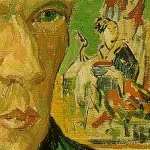
At various times in this blog, I've noted where I think it's appropriate, or at least acceptable, for writers of historical fiction to break from the known facts. I've done this in different parts of my novel, although the vast majority of scenes in it are directly inspired by documented incidents in Van Gogh's life and/or by recollections of him written (sometimes many years later) by people who knew him. Recently, I have been editing and tightening the Nuenen section of the novel. Nuenen was the town in which Vincent's father Theodorus held his last position as Dutch Reformed pastor before he passed away in 1885. Just as significantly, it was the town where Vincent lived and worked for almost two years, producing most of the better known paintings of what is now known as his "Dutch period." It was also the last time he lived inside his home country.
The Nuenen years were crucial in Van Gogh's artistic development. In fact, it is not so much the surface affairs of his life that matter most in this period, but the discoveries he made in his painting and the simple devotion he showed toward his craft. (And the fact that for the first time in years he wasn't starving.) One personal situation does stand out, however. He met a woman named Margot Begemann, the daughter of neighbors. Margot, still living with her parents though she was past forty, was not entirely in her right mind, something Vincent recognized and pitied her for, but for which he blamed her parents and their autocratic way of handling her. He felt that they had tried to keep her cloistered her entire life and that this had emotionally crippled Margot. After a period of taking walks and getting to know each other, Margot decided she was in love with Vincent. The two actually agreed to marry. The Begemanns were astounded and outraged. They refused to let Margot see Vincent anymore. Theodorus himself was deeply embarrassed by and deeply uncomfortable with the situation; the relationship between the two households became strained to the breaking point. Margot, distraught over being denied her "love," escaped from her confinement one day to meet with Vincent and walk with him. When she collapsed on the ground, she declared that she had poisoned herself. Vincent made sure she vomited, took her home, and then got her a doctor. Later, she was hospitalized, and he never saw her again.
It was a strangely short-lived if intense affair, one that made him very bitter--at his own family and the Begemanns--but which in the long run affected him astonishingly little. Much less so than his failure in London to woo Ursula Loyer, or his later infatuation with his cousin Kee, or his two year relationship with the woman he called Sien (in The Hague). I think this is because when he met Margot he was older, more jaded, just about convinced that a conventional marriage and family life was not in the cards for him. (This turned out to be true.) In imagining and crafting this section the novel, I've made the seemingly strange decision to remove Margot Begemann completely. Why, you might ask, when the affair causted so much turbulence? As I said above, for me the primary fact of Van Gogh's Nuenen years was his artistic not personal development; also, despite the Margot Begemann situation, Nuenen was a period in which Van Gogh did experience a small if crucial rapprochement with his family. His assistance in nursing his mother after she broke her hip showed the family he was quite human--and skilled--after all; and a grudging respect for his ability as a painter began to develop as well. Though he and his father never became close, they also didn't fight much, if only because Vincent had moved his studio to the house of the Catholic sexton and was seen less and less often at the Van Gogh homestead.
In earlier parts of the novel I detail Vincent's difficulties with women and with his own family. By the time the Nuenen period comes around, I think it's important for the arc of my plot to show Vincent's arrival as a painter. It is this subject that dominates the second half of my book. So as not to distract from that subject, and not to muddy the waters further with his family, I chose to remove Margot Begemann. It's an admittedly surprising, and even risky, move. But I hope it's a matter of addition by subtraction. Soon enough I'll be able to gauge whether or not I made the right call.













0 comments:
Post a Comment